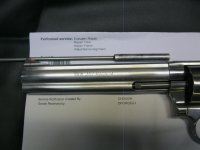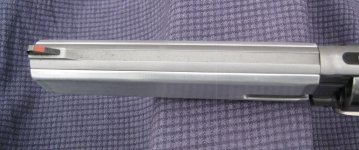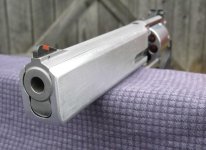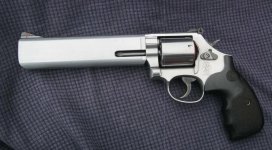8shot
Member
Just rec'd my 686 SKU 150855 with 7" barrel from the factory for the 2nd time.
My range rod will not pass through the barrel completely because it is torqued on too tight which reduces the bore diameter in the threaded area. I can actually see that the lands/grooves are deformed in front of the forcing cone using a bore light from the front.
I have (2) of these 7" revolvers (NEW)...the range rod will not pass through either one. In a nutshell the bullet diameter will be reduced entering the barrel then pass (rattle) through the remaining larger barrel bore diameter?
The factory will not address this condition specifically pointed out but continues to list other repairs they made that were not discussed or requested.
I do not have this "restricted" condition with any of my other S&W revolvers including 4" 686 models.
Obviously I can't verify cylinder/barrel alignment properly and feel that this is actually a safety issue more than an accuracy issue.
From what I hear this lack of quality is now the norm with new 686 revolvers? I bought these 7" revolvers intending to get back into Action Pistol but obviously won't have much confidence in them.
My range rod will not pass through the barrel completely because it is torqued on too tight which reduces the bore diameter in the threaded area. I can actually see that the lands/grooves are deformed in front of the forcing cone using a bore light from the front.
I have (2) of these 7" revolvers (NEW)...the range rod will not pass through either one. In a nutshell the bullet diameter will be reduced entering the barrel then pass (rattle) through the remaining larger barrel bore diameter?
The factory will not address this condition specifically pointed out but continues to list other repairs they made that were not discussed or requested.
I do not have this "restricted" condition with any of my other S&W revolvers including 4" 686 models.
Obviously I can't verify cylinder/barrel alignment properly and feel that this is actually a safety issue more than an accuracy issue.
From what I hear this lack of quality is now the norm with new 686 revolvers? I bought these 7" revolvers intending to get back into Action Pistol but obviously won't have much confidence in them.




